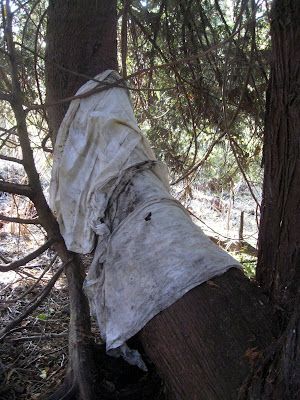
An important aspect of my work is the concept of time.

Not time as measured by a clock or calendar. I saw evidence of time each time I emptied the 7 threaded needles I took out to the tree. I felt time through my working hands. I saw changing time as the number of stitched rows increased. I saw time in the changing bands of colour on the sheets as the tree responded to climatic changes.

Rather than follow the Gregorian calendar to tell me when it was time to do the next colour study, I decided to follow the moon phases because they are linked to growth cycles in all living things.
I settled on the day of the new moon, a time of new growth.

Early human artifacts show marks recording moon cycles. Many North American Aboriginal tribes named each moon phase according to what they observed happened in nature.
From November 24th to December 24th I lived without watching any TV, reading newspapers, or listening to the radio. I went to bed when I was tired and got up when I woke up. I was mostly on my own and spent the time stitching and walking outside observing and listening. I wanted to develop a more instinctive awareness of time. I became aware of time in the present and stopped continually thinking of time as always passing me by.

I drew a graph to visually show the time schedule I needed to work to.
I found it interesting when I explained to people what my project was, most often their first comment was, 'That will take a lot of time'. They were right. It is all about 'Taking the Time'.









































